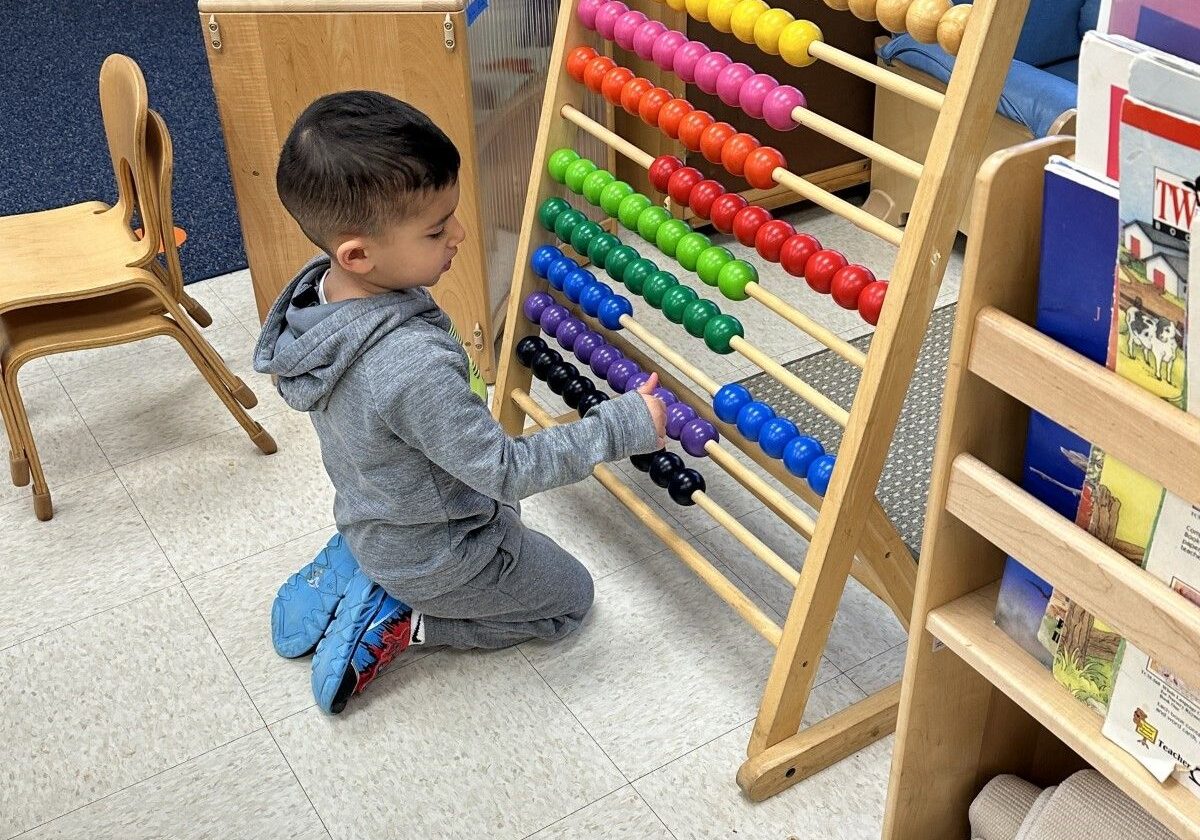Building towards Benchmarks in a Play-Based Curriculum: Math
February 21, 2023

Some key concepts of number sense for early childhood:
- One-to-one correspondence
- Understanding quantities
- Grasping concepts like greater than and less than, and larger and smaller
- Understanding 7 means the same thing as seven
At Morning Meeting in a Preschool class, the teacher presented an abacus to the class. As they went around the circle the children took turns counting aloud as the teacher moved each bead across. When a student needed help, other students were on hand to offer support. Collectively, they all counted the beads working towards one-to-one correspondence. This is a foundational mathematical skill that allows children to move past rote counting and to count rationally, consistently assigning one number to each item, giving a total value to answer the question ‘how many?’ In the other class, two students counted how many legs a spider has in preparation for creating a 3-D spider for their mural. Another child sorted counting bears and then determined which color he had the most of and of which he had the least.
In Junior Kindergarten centers, students explored different math manipulatives: dominoes, tangrams, and counting cards. At one table, students were using dominoes to practice identifying numbers by arrays, a skill that will help them as they learn to add and, later, multiply groups of numbers. At another table, they were building with tangrams and examining which sides of different shapes were equal and how when put together the shapes made a new shape! A third group was placing gems on the array below a numeral on each card to confirm what number it was, “One, two, three, four, …. FIVE!”
Kindergarten students sat in a circle as their teacher held up different cards, labeled with numbers and their spelling below. “One ten, 6 ones, 16!” “One ten, two ones, tw…” The teacher held up the card with 20 on it. “Two tens, zero ones, twenty!” She held up the 12 again. “One ten, two ones, twelve!” They discussed how even though both words start with “tw” they know the difference because one number has one ten and the other is made up of two tens. Not only were they decomposing numbers, identifying place value, and practicing number recognition, but also working on their sight words. The teacher-reviewed left and right and how we always read numbers from left to right. Next, the class practiced recognizing arrays for different numbers and then got up to match number words and dominoes that they had been handed behind their back.
There was a high engagement for this mathematical work as it was hands-on, student-centered, and meaningful to the students.
At home, we encourage you to:
In Junior Kindergarten centers, students explored different math manipulatives: dominoes, tangrams, and counting cards. At one table, students were using dominoes to practice identifying numbers by arrays, a skill that will help them as they learn to add and, later, multiply groups of numbers. At another table, they were building with tangrams and examining which sides of different shapes were equal and how when put together the shapes made a new shape! A third group was placing gems on the array below a numeral on each card to confirm what number it was, “One, two, three, four, …. FIVE!”
Kindergarten students sat in a circle as their teacher held up different cards, labeled with numbers and their spelling below. “One ten, 6 ones, 16!” “One ten, two ones, tw…” The teacher held up the card with 20 on it. “Two tens, zero ones, twenty!” She held up the 12 again. “One ten, two ones, twelve!” They discussed how even though both words start with “tw” they know the difference because one number has one ten and the other is made up of two tens. Not only were they decomposing numbers, identifying place value, and practicing number recognition, but also working on their sight words. The teacher-reviewed left and right and how we always read numbers from left to right. Next, the class practiced recognizing arrays for different numbers and then got up to match number words and dominoes that they had been handed behind their back.
There was a high engagement for this mathematical work as it was hands-on, student-centered, and meaningful to the students.
At home, we encourage you to:
- Notice numbers around you and in different contexts
- Count, identify numbers out of order, put numbers in order
- Connect numbers to a specific amount of something, and identify quantities as associated with a number. Compare groups of things using language like greater than, less than, and equal to
- Estimate how many there are of something and then count them.
- Begin to put quantities of things together (addition) and take them apart (subtraction).
Posted in Academics